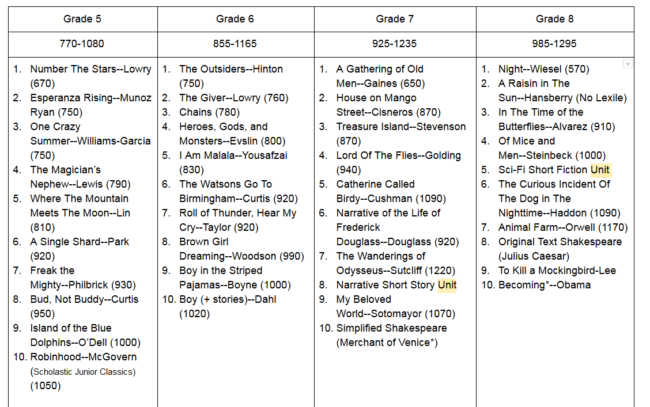01.23.19What Books Are Included in Our Reading Reconsidered English Curriculum?
Old Favorites and New Favorites–We Promise!
As you may know, we’re writing an English curriculum, my team and I.
As I’ve discussed elsewhere, it’s based on the reading of novels, challenging & demanding novels, at every grade level. It’s flexible and modular–teachers and schools can select from a range of books. It’s knowledge-building and writing intensive. It reinforces Close Reading of complex text. There’s a ton of nonfiction. It stresses the joy of reading. It’s moderately obsessed with vocabulary.
But, a lot of people have been asking: What books?? The books really matter! Are they challenging? Do they reflect and honor diversity? Do they reinforce cultural capital? Will they inspire kids (and teachers)?
We hope so! We spent months choosing them and consulted a team of experts to guide us. The list is still in draft form but here it is. (And we promise it will have a better name than “The Reading Reconsidered English Curriculum” soon!)

Some notes:
- There are ten books per grade. We think six books makes a full year’s study in most cases. So schools and teachers can select their ‘best six’ from the list. They can even use a book in a different grade level than we propose it.
- In our first round we’ll develop six of the ten at each grade level to get things into teachers’ hands. Then we’ll fill out the rest of the list.
- After that we may add more books or move on to other grades.
- The numbers in parentheses are Lexiles. We care about Lexiles but don’t obsess on them… we think there’s a lot more to a great book and that they are useful but flawed in assessing text difficulty.
- There’s some memoir built in. A few plays. Some short story units. When we say novels really we mean great literature in sustained chunks.
- There’s no perfect list. Of that we’re sure. But we tried to balance a lot of factors and like what we’ve got. Plus we think it gives teachers the opportunity to choose a sequence of texts that matches and challenges any group of students.
More soon!
[UPDATE: Whoops… left the author of “Chains” off the list… It’s Laurie Halse Anderson (and it’s a great read}

‘There’s a ton of nonfiction.’ Where?
it’s embedded constantly throughout the book units.
Curious about memoirs included for 7th and 8th grade. How about including Justice Thomas’s My Grandfather’s Son in 7th grade and Condoleeza Rice’s A Memoir of My Extraordinary, Ordinary Family in 8th grade to balance the political perspectives of Sotomayor and Obama?
Hadn’t thought of them but read and really enjoyed Justice Thomas’ book (it’s been a few years). Will read Condoleeza Rice’s. Thanks for the suggestions!
Thank you. I should have added that overall you have compiled a really good book list with diversity and challenging texts. I love the inclusion of Evslin and Sutcliff–kids love mythology! Good luck!
Are you working on a high school reading curriculum as well?
not yet. but we are somewhere between dreaming of it and planning it. 🙂
Will we be able to choose the curriculums we want individually or will schools have to purchase the entire thing? Or maybe you are selling them in sets of 6? What if I want 1-2?
not sure how we’re selling them yet. focusing on building them and then we’ll figure out rest. but our goal is to be as flexibile as possible so i’d expect that yes you will be able to buy just one or two.
Thank you for all off the work that went into creating a list like this. This link may offer some insight into the use of the novel Island of the BD.
https://americanindiansinchildrensliterature.blogspot.com/2016/06/a-critical-look-at-odells-island-of.html?m=1
Thank you for considering.
Will you be providing information/rationale as to why you picked these particular books? I understand it was a thoughtful and collaborative effort, yet I still am curious about your reasons.
Never easy making a list, but a list is essential.
I liked the list and think that it would be great if it were possible to read all ten but liked the six out of ten idea.
I’m so excited for this. The school I student taught at used TLAC and the skills in TLAC really helped me grow during my time there to the point where I bought the book for my own PD this year as a first year teacher. A lot of the units in the 8th grade section I teach at the 10th grade level and I can’t wait to see what these units look like (and hopefully use them in my own class when they’re released).
Thanks for sharing your excitement. We’ll keep working even harder to make sure they’re good enough. (Just reviewed the last lessons for the Giver yesterday. Our developer (Jen) did such an amazing job. I can’t wait to see it in action… hopefully w my own daughter. :))
This is fantastic! Can you tell me how you integrate language/grammar standards in the units? Do students attend an additional writing class where those are addressed? Again, love the rigor. I want to up my teaching game in the 50 minute ELA slot I teach.
for the most part we’ve tried to address grammar via developmental writing prompts. at some point i’ll try to write a blog post explaining how this works but Judith Hochman does a nice job addressing it in The Writing Revolution (a tremendous read regardless). I say “for the most part” because there may be a small number of students who need individual or small group remediation to be able to engage in the DR prompts successfully, but generally we think it’s a small number and applying grammar rules in intentional sentence exercises is our preferred method. and thanks also for your kind words.
Is The Giver unit ready for purchase or pilot?
yes. please write: tlac@uncommonschools.org